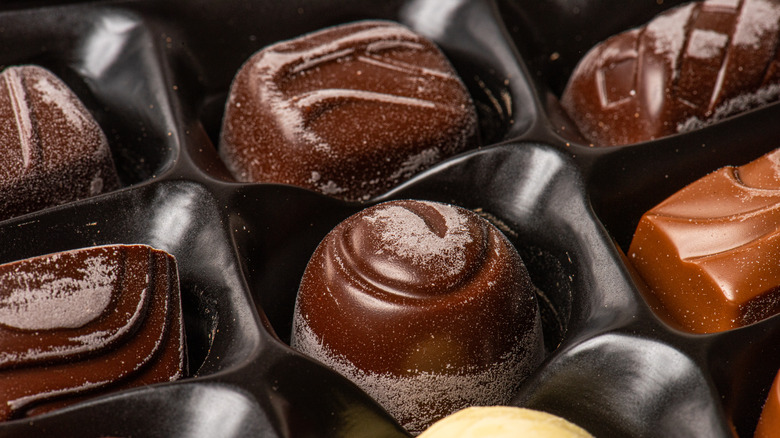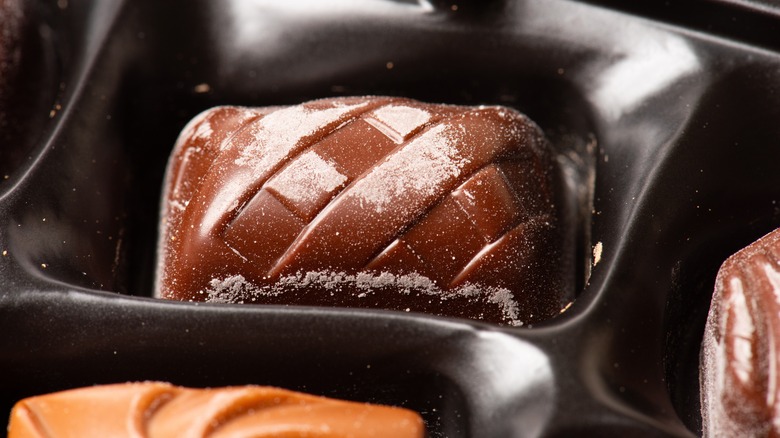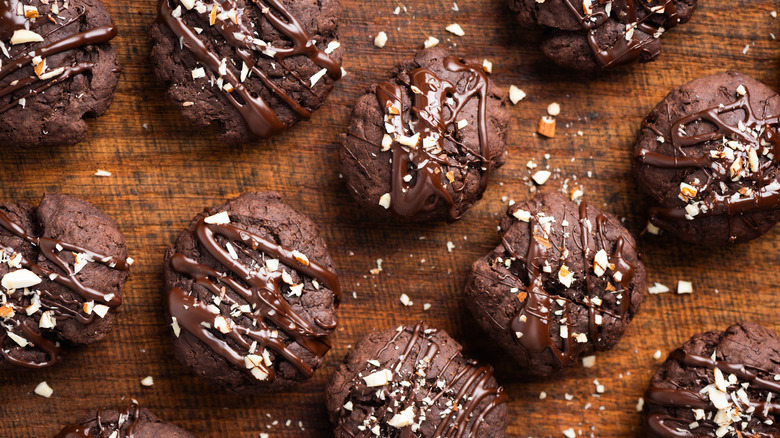What Is The White Dust On Your Chocolate (And Is It Safe To Eat)?
The world's obsession with chocolate is nothing new, having begun thousands of years ago in Mexico, where it's believed a ceremonial drink was made from the beans — or possibly pulp — of cacao pods (aka the fruit of the cacao tree, from which chocolate is derived). Since then, people have put this delicious commodity to use in far more ways than just a beverage, including in beautiful homebakes and decadent desserts like Boston cream pie.
But despite our familiarity with this famous ingredient, there's still one thing about it that has many of us stumped — and that's the odd white stuff that's sometimes found on its surface. Yes, most of us have likely experienced opening a bar of chocolate, only to discover this strange powdery or streaky substance gracing its exterior, and either a) throwing it away or b) throwing caution to the wind and eating it anyway.
This phenomenon is called chocolate bloom, and while it isn't particularly pretty and can also affect the chocolate's taste and texture, it's actually completely harmless. That's because it's not dust, mold, or, in fact, anything else you wouldn't want near your mouth — rather, it's the separation of ingredients within the chocolate itself.
Two types of chocolate bloom
Chocolate bloom can appear in two different forms (and sometimes even simultaneously), each with its own backstory. The powdery, white kind of bloom, known as sugar bloom, is the result of the sugar inside the chocolate evaporating and then resettling on the surface as crystals, which happens when it is exposed to either humidity or moisture (say, from being kept inside the refrigerator) or a rapid change in temperature. In addition to affecting the chocolate's appearance, this can also cause it to develop a gritty or grainy texture that isn't as pleasant to taste but can certainly still be eaten.
Similarly, the streaky, white and grey kind of bloom — known as fat bloom — occurs when chocolate has been stored in too warm of an environment, causing the cocoa butter to melt, resolidify, and reappear on the surface as crystals. However, this doesn't always come down to improper storage on the consumer's part; it can also happen during manufacturing if the chocolate isn't tempered correctly. Once again, this chocolate may not look or taste quite the way it was intended, but there is absolutely no harm in eating it.
How to use bloomed chocolate (and avoid it altogether)
If you can move past its imperfections, there are plenty of other ways to utilize bloomed chocolate. Chopping it up or melting it down to use in your favorite bakes and desserts is ideal, as this helps to hide its flawed appearance while essentially reversing the separation process that created the issue in the first place. If you're looking for recipe inspiration, try these chewy coconut chocolate chip cookies or this chocolate mousse.
And if you want to avoid bloomed chocolate altogether, take the advice of leading New York chocolatier and "Nailed It!" head judge Jacques Torres, who emphasizes the importance of proper storage. According to the official Jacques Torres Chocolate website, sugar bloom can be largely prevented by either putting chocolate into an air-tight container or wrapping it in multiple layers of plastic wrap before placing it in the refrigerator. When ready to eat, this should be brought to room temperature slowly to prevent condensation — a couple of hours on the counter is all you need. To avoid fat bloom, on the other hand, you'll want to keep chocolate in a cool, dark, and dry place where the temperature sits comfortably at 70 degrees Fahrenheit or below. However, if you do happen to find the latter covering your chocolate, Torres says it's as easy as wiping your fingertips over the surface — a simple act that will essentially melt away the layer of fat. Who knew?


